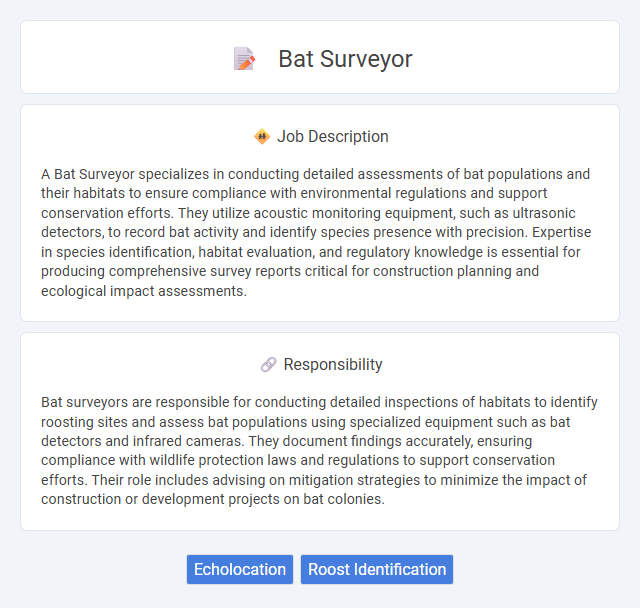
A Bat Surveyor specializes in conducting detailed assessments of bat populations and their habitats to ensure compliance with environmental regulations and support conservation efforts. They utilize acoustic monitoring equipment, such as ultrasonic detectors, to record bat activity and identify species presence with precision. Expertise in species identification, habitat evaluation, and regulatory knowledge is essential for producing comprehensive survey reports critical for construction planning and ecological impact assessments.
Individuals with a strong interest in wildlife and excellent observational skills are likely to be suitable for a Bat Surveyor role. Physical fitness and the ability to work outdoors in various weather conditions increase the probability of success in this job. People who prefer solitary or small team environments might find the work more compatible with their preferences.
Qualification
Bat Surveyor roles typically require strong expertise in ecology or environmental science, often supported by a bachelor's degree in biology, zoology, or related fields. Proficiency in bat identification, acoustic survey techniques, and familiarity with key legislation such as the Wildlife and Countryside Act are essential qualifications. Experience with survey equipment like ultrasonic detectors and knowledge of habitat assessment methods significantly enhance job performance and employability.
Responsibility
Bat surveyors are responsible for conducting detailed inspections of habitats to identify roosting sites and assess bat populations using specialized equipment such as bat detectors and infrared cameras. They document findings accurately, ensuring compliance with wildlife protection laws and regulations to support conservation efforts. Their role includes advising on mitigation strategies to minimize the impact of construction or development projects on bat colonies.
Benefit
A Bat Surveyor likely gains valuable expertise in wildlife conservation and ecological assessment, enhancing career opportunities in environmental science. The role probably offers hands-on experience with cutting-edge monitoring technology and data collection methods. There is a strong chance of contributing meaningfully to biodiversity preservation, which may provide personal fulfillment and professional recognition.
Challenge
Bat surveyor roles likely involve challenging fieldwork in diverse and sometimes difficult environments, requiring careful observation and data collection skills. The probability of encountering unpredictable weather and elusive bat activity may add complexity to survey schedules. Adapting to these factors and maintaining accurate records is essential for effective bat conservation efforts.
Career Advancement
Bat Surveyor careers offer progressive advancement opportunities through gaining expertise in chiropterology, environmental assessment, and habitat conservation. Professionals can move from field survey roles to specialist consultancy positions, project management, and senior ecological advisory roles within environmental agencies or private firms. Developing skills in bat identification, acoustic analysis, and regulatory compliance enhances prospects for leadership positions and involvement in large-scale biodiversity projects.
Key Terms
Echolocation
Bat Surveyors specialize in detecting and analyzing bat echolocation calls to assess species presence and activity patterns. Using ultrasonic detectors and advanced software, they capture high-frequency sounds beyond human hearing, enabling accurate identification of bat species and population density. Their work supports conservation efforts by informing habitat protection and mitigating impacts of construction projects on bat populations.
Roost Identification
Bat surveyors specializing in roost identification conduct detailed inspections to locate and characterize bat roosts using methods such as visual surveys, acoustic monitoring, and thermal imaging. They meticulously analyze features like crevices, tree hollows, and man-made structures, ensuring compliance with wildlife protection regulations and contributing to conservation efforts. Expertise in bat species' habitat preferences and seasonal roosting behavior enables accurate mapping and assessment critical for environmental impact assessments.
 kuljobs.com
kuljobs.com